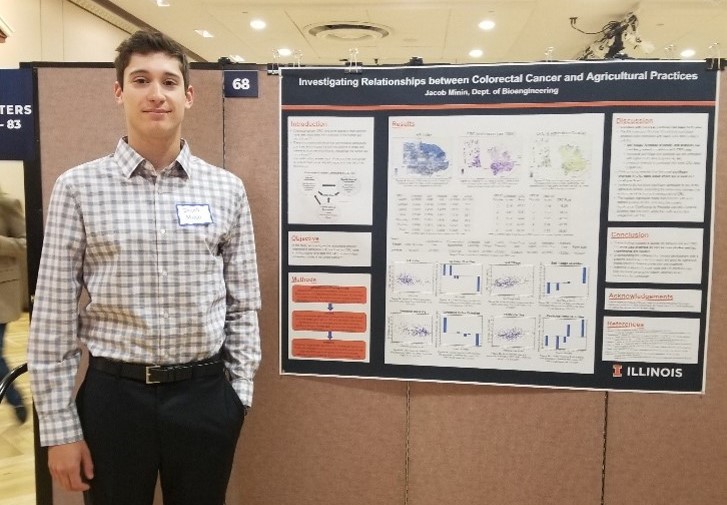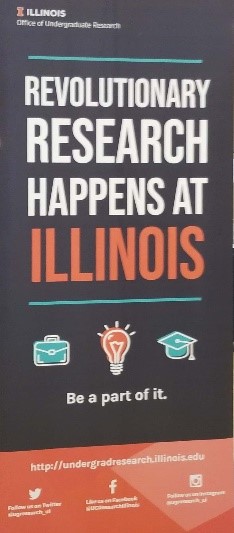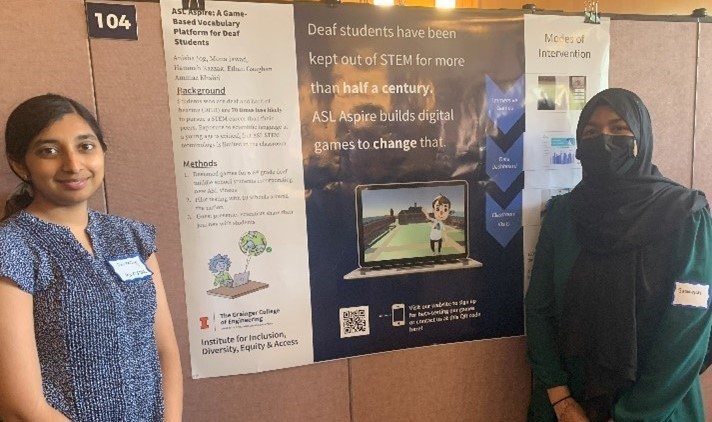Innovation, Inspiration on display at the Undergraduate Research Symposium

At left and right, University of Illinois students Prithika Ravi and Leah Malan and University High School Student Dan Rosu (center), flank their visual presentation at the 2023 Undergraduate Research Symposium at the U of I campus in May. Their team’s research examined how exercise in mice produces exosomes that stimulate growth in brain cells.
By Bruce Adams, Contributing Writer
June 1, 2023
Walking into the Illini Union ground floor conference rooms during the Undergraduate Research Symposium is a dizzying and inspiring experience It’s a smorgasbord of inquiry and experimentation across academic programs and departments covering everything from autism in rats to NFL contracts. And more.
Undergraduate Research Week took place April 23-29, 2023, and culminated Thursday, April 27, 2023, in its signature event: the Undergraduate Research Symposium. Since 2008, undergraduates from across the University of Illinois Urbana-Champaign have presented their work in concurrent oral and poster presentations. The number of participants has grown, with over 800 gathered this year. The breadth and scope of their research speak to the caliber of Illinois undergraduates, the mentoring they receive from faculty, and the university’s commitment to supporting and expanding research opportunities on campus, in the community, and beyond.
Here are just a few of the presentations from the symposium.
Investigating Relationships between Colorectal Cancer and Agricultural Practices

University of Illinois student Jacob Minin stands by a display of his research, which uncovers the relationship between farming practices to colorectal.
For his campus honors class, Jacob Minin (Bioengineering), collated county-level data from the Midwest to uncover the relationship between farming practices and colorectal cancer rates. His mentor, Warren Levy (Law), described Minin as a “superstar” and noted that the senior would begin working at the National Institutes of Health after graduation.
Minin compared a crop diversity index covering cereals, feedstock, vegetables, and fruit against several other factors like soil quality to create a county-by-county map of colorectal cancer rates. He also ran leukemia rates to confirm the relationship of gut biomes to colorectal cancer.

The Role of Exosomes in Exercise-Induced Neurogenesis
Senior Leah Malan (Psychology), sophomore Prithika Ravi (Brain and Cognitive Science), and University High School student Dan Rosu, were mentored by Justin Rhodes (Psychology) and Meghan Connolly (Neuroscience Program). The team’s research examined how exercise in mice produces exosomes that stimulate growth in brain cells.
Prithika Ravi said that her formative experiences in STEM began at University High School as a volunteer in the lab with Dr. Rhodes and her senior project. She would like to pursue research in blood vessels in the future.
Learning To Sign Through Games:
An ASL STEM Vocabulary App
Senior Mona Jawad (Bioengineering), senior Amy Lee (Bioengineering) junior Sumayyah Hussain (Mechanical Engineering), sophomore Anisha Jog (Computer Science) freshman Aneesh Nagalkars (Computer Engineering) were mentored by Holly Golecki, (Bioengineering).
This team addressed barriers that deaf and hard-of-hearing students have to a STEM education and why there is a relatively low proportion of deaf and hard-of-hearing students working towards STEM careers.

Photo provided. University of Illinois students Anisha Jog and Sumayyah Hussain stand by their presentation on the ASL STEM Vocabulary App, a game-based learning platform their team created to remove barriers that deaf and hard-of hearing students have when learning STEM-based vocabulary.
Hussain said: “One of the big things that we realized after talking to teachers, students, and deaf professionals was that vocabulary is one of the biggest issues for users of American Sign Language. Words are coming out every single day. These are often technical vocabularies like nucleus, chromosome, and mitochondria. These words might not have been out 20 years ago, but they are now. There's a question of access, especially for middle school students and teachers, when they get these words. It becomes harder for students to explore these concepts than further to learn more, be curious about them, and have that level of education.”
The team’s solution is a game-based education and a game-based educational learning platform in the form of an app and website. I-STEM director Luisa-Maria Rosu provided mentoring for the project's educational component, working with team leader Mona Jawad directly for three years. The Carle Illinois College of Medicine Health Maker Lab, provided funding.
As Jawad put it: “This university is incredible because they have a lot of research education. We contacted all sorts of people across the university in a million different departments. We've reached out to people in the computer science, bioengineering, and education departments. The fact that everybody feeds into each other at the university level is helpful for startups and research like this because they are naturally interdisciplinary.”
A startup is on track to being launched, and the students are on their way to pilot studies at high schools in Indiana and Ohio.
Mixmaster 9000
Senior Jason Brickman, (Dance), who calls himself “a dancer by trade” taught himself programming to create the Mixmaster 9000 to “mix in everything you can imagine.”
Dissatisfied with viewing large video screens devoted to sports broadcasts while he was out dancing at clubs, he wondered how the dancers could become the video stream.
His mentor John Toenjes (Dance), used the Isadora software program to combine the video and audio processing engine of a media server with a hyper-flexible visual programming environment to create an incredibly versatile media playback platform for interactive digital performances.
Brickman coded a digital turntable to mix video streams and add multiple effects. Like mixing vinyl records, the resulting process is hands-on, allowing someone to mix videos and add effects on the fly. The Mixmaster 9000 can modify live videos of performances and dancing, and mix in layers of effects in venues from clubs to theaters to stadiums.
Stay tuned for more stories on two of these research teams at the University of Illinois as we discover how students’ interest in STEM percolates from high school to examples of the mentoring they received and multi-disciplinary collaboration on campus.












.jpg)
















